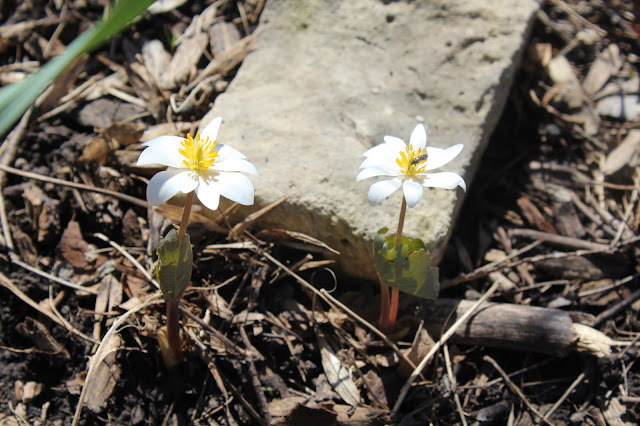I saw my first lazy bumble emerge on Friday. Maybe it was a queen, setting out to start a new colony. Maybe it was a worker, preparing to search out the first nector of the season. Either way my garden was ready. I try to have as many of the early bloomers as possible for those first pollinators. I won't see any hummingbirds for weeks but I've seen a few colony bees as well as solitary bees.
Today I saw the first bumble bee out collecting nectar. They like the pulmonaria as you can see. The hummingbirds do, as well.

Tiny pollinators for tiny flowers. The blood rood just opened here.
I don't know that I've ever seen bees around the Vinca, aka, Virginia Creeper, or maybe I've just forgotten.
 I've definitely seen all sorts of pollinators, especially bees in the Virginia Blue Bells which are just about to open.
I've definitely seen all sorts of pollinators, especially bees in the Virginia Blue Bells which are just about to open.Daffodils never seem to attract bees or hummingbirds and our butterflies don't emerge until after the daffodils are done blooming.
I've heard a lot lately about old world vs new world plants and their usefulness to pollinators in our areas. Hummingbirds are only attracted to plants that are native to North America, Central America and South America. They may, in fact only be able to process nectar from flowers from this hemisphere.
I'll have to keep that in mind as I choose plants for the garden, to be sure I'm providing a diversity of flowers for the birds and bees.

We saw a lot of native primrose when we visited Northern Ireland.
Color Spectrum is another consideration. Bees can't see red but can see orange and yellow. Hummingbirds are very attracted to red, purple and blue. Butterflies can see most colors and even see in the ultraviolet range that we cannot see. It's quite amazing. I don't claim to know enough about it yet but plan to look into it. For now, I'll just plan to provide as much variety as possible.
Early blooming shrubs like this forsythia are a joy. I'll have to keep an eye out for bees around it. This is not a difficult task, as I could look at it all day, it's so pretty.











No comments:
Post a Comment